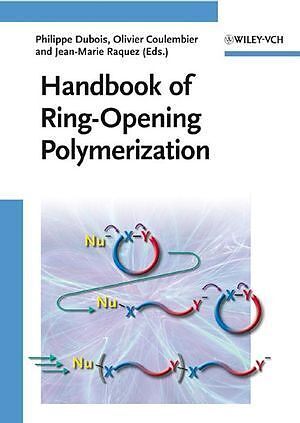Handbook of Ring-Opening Polymerization
Einband:
Fachbuch
EAN:
9783527319534
Genre:
Chemistry
Autor:
Philippe Dubois, Olivier Coulembier, Jean-Marie Raquez
Herausgeber:
Wiley VCH Verlag GmbH
Dieser Band beantwortet Ihnen wirklich jede Frage zur Ringöffnungspolymerisation: Monomere, Methoden, Stereochemie, Anwendungen und Spezialgebiete werden gleichermaßen ausführlich und auf dem neuesten Stand beschrieben. Die wichtigsten Monomerklassen (Heterocyclen, cyclische Olefine und Alkine, Cycloalkane) werden jeweils separat besprochen; für alle Prozesse finden Sie Mechanismen und Angaben zu den Eigenschaften der polymeren Produkte. Zwei abschließende Kapitel diskutieren die Ringöffnungspolymerisation im Kontext der Grünen Chemie.
Autorentext
Philippe Dubois received his PhD degree from University of Liège. In 1997 he moved to University of Mons-Hainaut (UMH) where he obtained the chair of macromolecular chemistry and directed the Laboratory of Polymeric and Composite Materials. He has co-authored more than 350 peer-reviewed publications and is co-inventor of 40 patents. He co-edited 5 books. In 2007 he became Director of of The Center of Innovation and Research in Materials and Polymers (CIRMAP) at UMH. He is currently past-president of the Belgian Royal Chemical Society (president in 2006-2007) and scientific director of Materia Nova research center in Mons. Olivier Coulembier received his PhD degree from University of Mons-Hainaut, Belgium in 2005 and joined the University of Stanford (United States) for his postdoctoral research in 2006. He is currently Research Associate by Belgian F.R.S.-FNRS in the Laboratory of Polymeric and Composite Materials (Professor Philippe Dubois) at University of Mons-Hainaut. His main activities are focused on the (non)organometallic ring-opening polymerization of cyclic monomers. He has authored 24 scientific papers in international journals. Jean-Marie Raquez, PhD in chemistry um UMH, Belgium, is currently postdoctoral researcher by Belgian F.R.S.-FNRS and works in the Laboratory of Polymeric and Composites Materials (Professor Philippe Dubois) at University of Mons-Hainaut (UMH) in Mons, Belgium. He has authored 12 scientific papers and 5 US patents in Materials Technology including macromolecular synthesis and reactive processing. In 2004, he joined the Michigan State University, USa, for his postdoctoral research.
Klappentext
Polymers and Copolymers obtained by ring-opening polymerization comprise a large portion of the engineering plastics industry and are used for preparation of many specialty materials, such as Nylon 6 and poly(propylene oxide). Written by internationally acclaimed experts in their respective fields, this comprehensive, one-stop reference discusses cyclic monomers, polymerization methods, stereochemistry, industrial applications and more. All the main classes of monomers are discussed separately, together with their specifities regarding the ring-opening polymerization techniques, the mechanisms, the degree of control, the properties of the related polymers and their applications.
Inhalt
THERMODYNAMICS AND KINETICS OF RING-OPENING POLYMERIZATION Introduction Thermodynamics of the Ring-Opening Polymerization Kinetics of Ring-Opening Polymerization GENERAL MECHANISMS IN RING-OPENING POLYMERIZATION Introduction Anionic Ring-Opening Polymerization Cationic Ring-Opening Polymerization Radical Ring-Opening Polymerization SILOXANE-CONTAINING POLYMERS Introduction Polydimethylsiloxanes Functional Silicones Polycarbosiloxanes SULFUR-NITROGEN-PHOSPHOROUS-CONTAINING POLYMERS Introduction Mechanism and Methods in Ring-Opening Polymerization (ROP) of Halogenated Cyclotriphosphazanes Ring-Opening Polymerization and Chemistry of Nonhalogenated Phosphazane Rings Incorporation of Sulfur into Phosphazane Ring Systems and Their Polymerization Chemistry POLYMERIZATION OF CYCLIC DEPSIPEPTIDES, UREAS AND URETHANES Introduction Polydepsipeptides Monomers Ring-Opening Polymerization Enzymatic Polymerization Ring Expansion Polyureas Polyurethanes POLYETHERS AND POLYOXAZOLINES Introduction Polyethers Polyoxazolines POLYAMIDES Introduction Mechanism of the Anionic Polymerization of Lactams Initiators for the Anionic Polymerization of Lactams Activators for Anionic Polymerization of Lactams Nonactivated Polymerization Cyclic Oligomers of Epsilon-Caprolactam Block Copolymers of Lactams Anionic Copolymerization of Epsilon-Caprolactam with Omega-Laurolactam Copolymerization of Lactams with Lactones (Epsilon-Caprolactone) Powdered Polyamide Nanocomposites Anionic Polymerization of 2-Pyrrolidone RING-OPENING METATHESIS POLYMERIZATION General Introduction Introduction to Ring-Opening Metathesis Polymerization (ROMP) Well-Defined Catalysts for ROMP `Living? ROMP Selected Recent Applications and Developments POLYESTERS FROM BETA-LACTONES Introduction Beta-Lactones Preparation Ionic Polymerization Coordination Process Carbene-Based Polymerization Enzymatic Polymerization Illustrative Experimental Section POLYESTERS FROM DILACTONES Introduction General Concepts and ROP Promoted by Metallic Recent Advances in ROP Macromolecular Engineering Applications POLYESTERS FROM LARGE LACTONES Introduction Controlled Synthesis of Linear Polyesters Physical Properties of Polymers POLYCARBONATES Introduction Polymerization of Cyclic Carbonates: Homopolymers and Block Copolymers POLYMERIZATION OF CYCLOALKANES Introduction General Overview and Thermodynamic Requirements Structure-Reactivity Relationships Based on a Comprehensive Survey of the Current Literature METAL-FREE CATALYSIS IN RING-OPENING POLYMERIZATION Introduction Nucleophilic ROP Metal-Free Ionic ROP ENZYME-MEDIATED RING-OPENING POLYMERIZATION Introduction Characteristics of Enzymatic ROP Classes of Monomer Polymer Architectures Employing Enzymatic ROP

Leider konnten wir für diesen Artikel keine Preise ermitteln ...
billigbuch.ch sucht jetzt für Sie die besten Angebote ...
Die aktuellen Verkaufspreise von 6 Onlineshops werden in Realtime abgefragt.
Sie können das gewünschte Produkt anschliessend direkt beim Anbieter Ihrer Wahl bestellen.
Loading...
Die aktuellen Verkaufspreise von 6 Onlineshops werden in Realtime abgefragt.
Sie können das gewünschte Produkt anschliessend direkt beim Anbieter Ihrer Wahl bestellen.
| # | Onlineshop | Preis CHF | Versand CHF | Total CHF | ||
|---|---|---|---|---|---|---|
| 1 | Seller | 0.00 | 0.00 | 0.00 |
